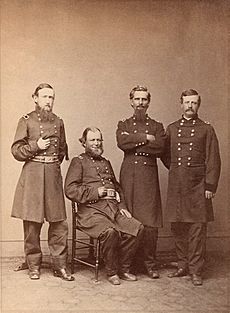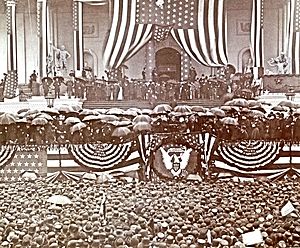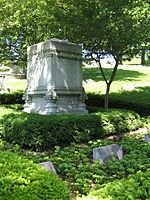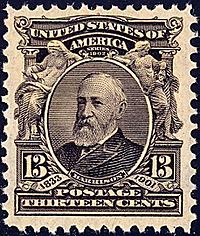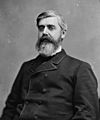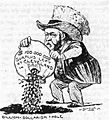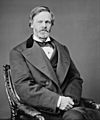Benjamin Harrison facts for kids
Quick facts for kids
Benjamin Harrison
|
|
|---|---|
 |
|
| 23rd President of the United States | |
| In office March 4, 1889 – March 3, 1893 |
|
| Vice President | Levi P. Morton |
| Preceded by | Grover Cleveland |
| Succeeded by | Grover Cleveland |
| United States Senator from Indiana |
|
| In office March 4, 1881 – March 4, 1887 |
|
| Preceded by | Joseph McDonald |
| Succeeded by | David Turpie |
| Personal details | |
| Born | August 20, 1833 North Bend, Ohio |
| Died | March 13, 1901 (aged 67) Indianapolis, Indiana |
| Cause of death | Influenza-related pneumonia |
| Nationality | American |
| Political party | Republican |
| Spouses | Caroline Scott Harrison (1st wife) Mary Scott Lord Dimmick (2nd wife) |
Benjamin Harrison (born August 20, 1833 – died March 13, 1901) was the 23rd president of the United States. He served from 1889 to 1893.
He was the grandson of another U.S. President, William Henry Harrison. Benjamin Harrison is the only grandson of a president to also become president. His home was in Indianapolis, Indiana.
Harrison was a member of the Republican party. He won the election in 1888, defeating the president at the time, Grover Cleveland. After Harrison served one four-year term, Cleveland ran again and won, beating Harrison.
During the American Civil War, Harrison was a colonel in the Union Army. He later became a brevet brigadier general. A brevet rank is a temporary higher rank given for bravery.
He was also a very good lawyer. He argued many cases in front of the highest court, the United States Supreme Court.
Contents
Early Life and Family
Benjamin Harrison was born on August 20, 1833, in North Bend, Ohio. He was the second of ten children born to Elizabeth Ramsey (Irwin) and John Scott Harrison.
His grandfather was U.S. President William Henry Harrison. His great-grandfather, Benjamin Harrison V, signed the Declaration of Independence. This shows he came from a family with a strong history in American politics.
Benjamin had a fun childhood. He spent a lot of time outdoors, fishing and hunting. He first went to school in a small log cabin. Later, his parents hired a tutor to help him prepare for college.
Starting a Career and Marriage
After finishing college in 1852, Harrison began studying law. He learned from Judge Bellamy Storer in Cincinnati. Before he finished his law studies, he returned to Oxford, Ohio.
He married Caroline Scott on October 20, 1853. They had two children together. Their son was Russell Benjamin Harrison, and their daughter was Mary "Mamie" Scott Harrison.
Harrison started working as a lawyer in 1854. From 1862 to 1865, he served as a commander in the Union Army during the American Civil War. After the war, he served as a senator for Indiana. His term as senator lasted from March 4, 1881, to March 3, 1887.
Benjamin Harrison's Presidency (1889–1893)
As president, Benjamin Harrison wanted to increase tariffs. Tariffs are taxes on goods brought into the country from other places. He had two main reasons for this.
First, higher tariffs would bring more money to the U.S. government. This money could then be used to pay for important government projects. Second, he believed in something called protectionism. This idea means that high tariffs would make American-made goods cheaper than foreign ones. This would encourage people to buy more products made in the USA.
Harrison used the money from these tariffs to help injured soldiers. These were veterans from the American Civil War.
He was the first president to have a government budget of over a billion dollars. Some people criticized him for this large spending.
He also signed the Sherman Anti-Trust Act. This law gave the U.S. government power to control very large businesses. It helped prevent monopolies, where one company controls an entire industry.
Sadly, his first wife, Carrie Harrison, passed away in 1892 while he was still president.
During Harrison's time as president, the United States saw many new inventions. Science and technology were advancing quickly. We even have a recording of his voice from 1889. This is the earliest recording of a president while they were in office.
Harrison also had electricity installed in the White House for the very first time. It was put in by the Edison General Electric Company. However, he and his wife were afraid to touch the light switches. They worried about getting an electric shock. Because of this, they often went to sleep with the lights still on!
Harrison also worked to make the U.S. Navy much stronger. When he became president, the Navy had only two active warships. He believed the country needed a powerful navy to protect itself.
His Secretary of the Navy, Benjamin F. Tracy, led the effort to build many new ships. Within a year, Congress approved building several new warships. By 1898, the U.S. Navy had ten modern warships. These ships had strong steel hulls and powerful weapons. Seven of these ships began construction during Harrison's presidency. This made the United States a strong naval power.
New States Join the Union
More states joined the United States during Harrison's presidency than any other. These new states are:
- North Dakota – November 2, 1889
- South Dakota – November 2, 1889
- Montana – November 8, 1889
- Washington – November 11, 1889
- Idaho – July 3, 1890
- Wyoming – July 10, 1890
Life After Presidency and Death (1893–1901)
In 1896, at age 62, Harrison married again. His second wife was Mary Scott Lord Dimmick. Benjamin and Mary had one child together, a daughter named Elizabeth.
Benjamin Harrison passed away from pneumonia on March 13, 1901. He was 67 years old. He died at his home in Indianapolis. Harrison is buried in Crown Hill Cemetery in Indianapolis. His first wife, Caroline, is buried next to him. His second wife, Mary, was also buried there after her death in 1948.
Benjamin Harrison's Legacy
Benjamin Harrison has been honored in several ways. His image has appeared on many postage stamps. The first was a 13-cent stamp issued in 1902. In total, he has been on six U.S. Postage stamps, which is more than most other presidents.
In 1908, the people of Indianapolis put up a statue of Benjamin Harrison. It honors his achievements as a military leader, U.S. Senator, and President. The statue is in University Park.
In 1951, Harrison's home was opened to the public. It became a library and museum. The house was named a National Historic Landmark in 1964.
Interesting Facts About Benjamin Harrison
- Benjamin Harrison was the 23rd President of the United States.
- He was the first president to have electricity in the White House.
- Harrison was seven years old when his grandfather, William Henry Harrison, became president. Benjamin did not go to the inauguration.
- He had a few nicknames. The most famous was “The Human Iceberg.” This was because he often seemed stiff and cold in his personality.
- He was very concerned about germs. He always wore gloves when shaking hands with people.
- When he was elected in 1889, he was called the “Centennial President.” This was because it had been 100 years since George Washington first became President in 1789.
Images for kids
-
Birthplace marker in North Bend, Ohio
-
Harrison during the Battle of Resaca leading the 70th Indiana, May 1864; Harrison was a colonel at the time.
-
Battle of Resaca, in Georgia, where Harrison served under General Sherman
-
Walter Q. Gresham, Harrison's rival within the Indiana Republican Party
-
Eastman Johnson's portrait of Benjamin Harrison, c. 1890–1900
-
Senator John Sherman worked closely with Harrison, writing bills regulating monopolies and monetary policy.
-
Harrison with Secretary Blaine and Representative Henry Cabot Lodge off the coast of Maine, 1889
-
Harrison's cabinet in 1889 Front row, left to right: Harrison, William Windom, John Wanamaker, Redfield Proctor, James G. Blaine Back row, left to right: William H. H. Miller, John Willock Noble, Jeremiah M. Rusk, Benjamin F. Tracy
-
Official White House portrait of Benjamin Harrison, painted by Eastman Johnson
See also
 In Spanish: Benjamin Harrison para niños
In Spanish: Benjamin Harrison para niños


